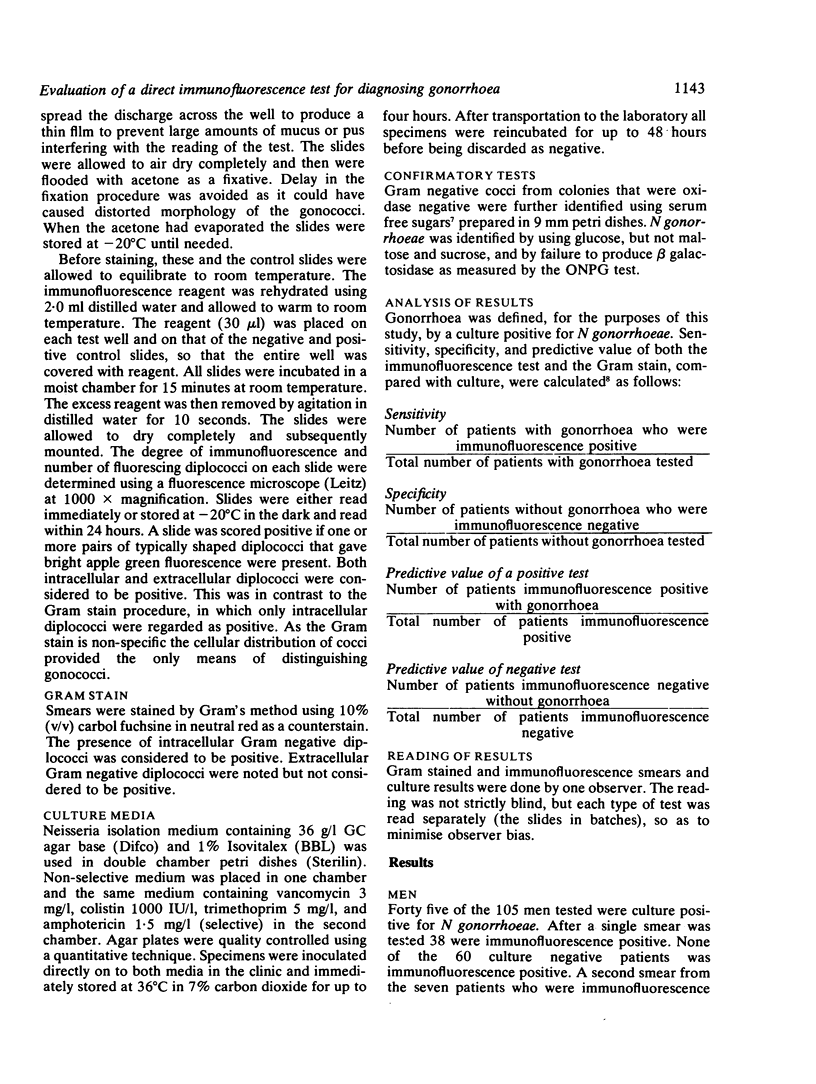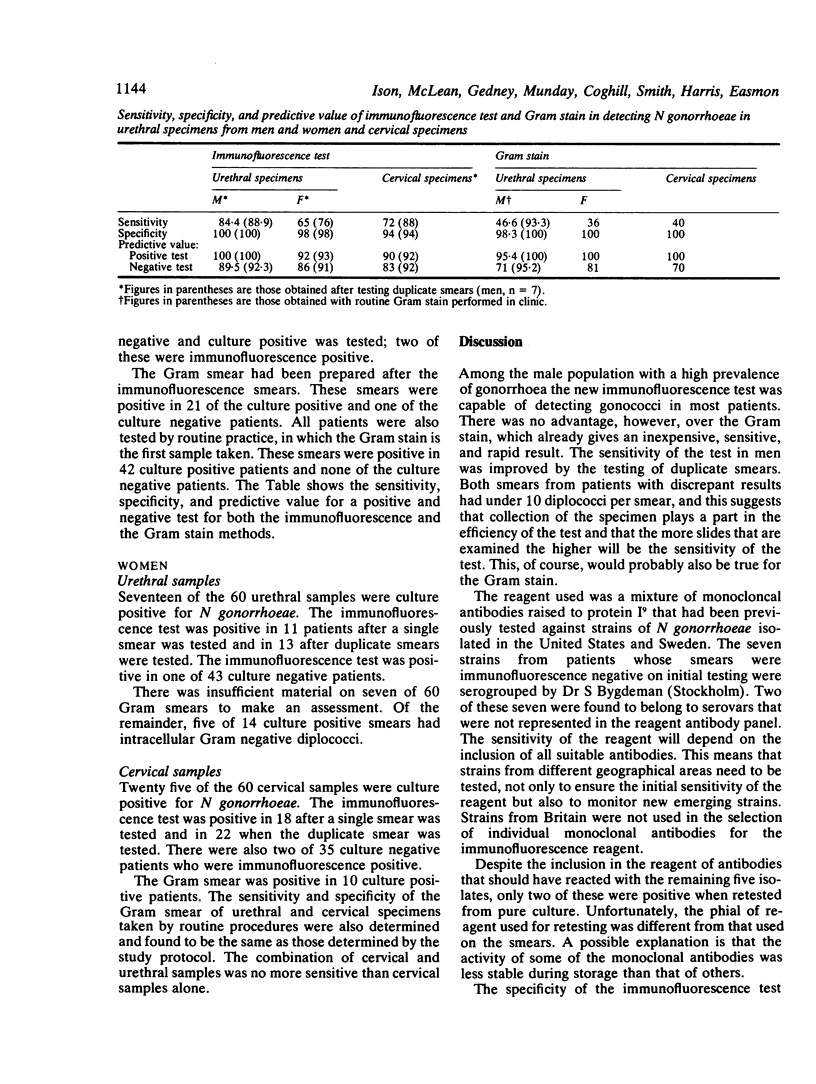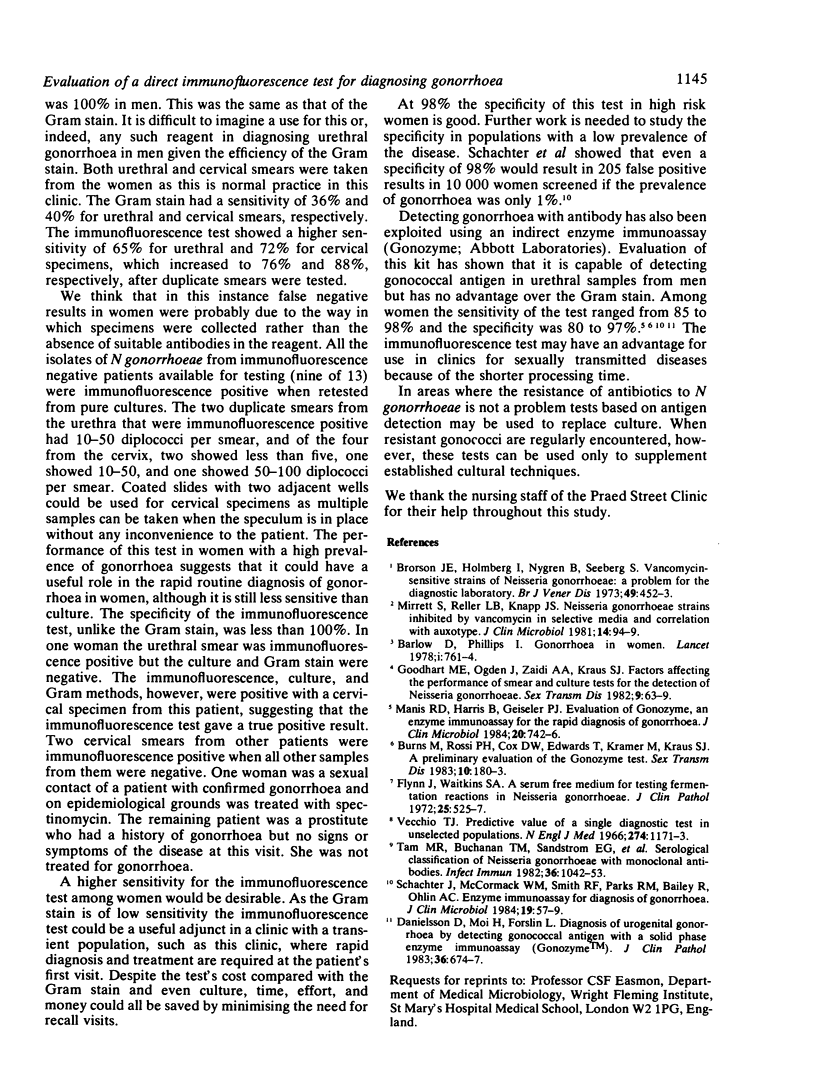Abstract
A new direct immunofluorescence reagent (Syva and Genetic Systems Inc) was evaluated for its ability to detect Neisseria gonorrhoeae in specimens from populations with a high prevalence of the infection. Gonorrhoea was diagnosed by culture in 45 of 105 (43%) urethral specimens from men and 17 of 90 (28%) urethral and 25 of 60 (42%) cervical specimens from women. In men the immunofluorescence test had a sensitivity of 84.4% and a specificity of 100%; Gram staining gave values of 94% and 100%, respectively. The sensitivity of the immunofluorescence test could be increased to 89% by testing duplicate smears. In women the immunofluorescence test had a sensitivity of 65% and a specificity of 98% for urethral samples and values of 72% and 94%, respectively for cervical samples. At both sites the sensitivity of the Gram stain was 40% and the specificity 100%. The testing of duplicate immunofluorescence smears increased the sensitivity to 76% for urethral and 88% for cervical samples.
Full text
PDF



Selected References
These references are in PubMed. This may not be the complete list of references from this article.
- Barlow D., Phillips I. Gonorrhoea in women. Diagnostic, clinical, and laboratory aspects. Lancet. 1978 Apr 8;1(8067):761–764. doi: 10.1016/s0140-6736(78)90870-x. [DOI] [PubMed] [Google Scholar]
- Brorson J. E., Holmberg I., Nygren B., Seeberg S. Vancomycin-sensitive strains of Neisseria gonorrhoeae. A problem for the diagnostic laboratory. Br J Vener Dis. 1973 Oct;49(5):452–453. doi: 10.1136/sti.49.5.452. [DOI] [PMC free article] [PubMed] [Google Scholar]
- Burns M., Rossi P. H., Cox D. W., Edwards T., Kramer M., Kraus S. J. A preliminary evaluation of the Gonozyme test. Sex Transm Dis. 1983 Oct-Dec;10(4):180–183. doi: 10.1097/00007435-198311000-00003. [DOI] [PubMed] [Google Scholar]
- Danielsson D., Moi H., Forslin L. Diagnosis of urogenital gonorrhoea by detecting gonococcal antigen with a solid phase enzyme immunoassay (Gonozyme). J Clin Pathol. 1983 Jun;36(6):674–677. doi: 10.1136/jcp.36.6.674. [DOI] [PMC free article] [PubMed] [Google Scholar]
- Flynn J., Waitkins S. A. A serum-free medium for testing fermentation reactions in Neisseria gonorrhoeae. J Clin Pathol. 1972 Jun;25(6):525–527. doi: 10.1136/jcp.25.6.525. [DOI] [PMC free article] [PubMed] [Google Scholar]
- Goodhart M. E., Ogden J., Zaidi A. A., Kraus S. J. Factors affecting the performance of smear and culture tests for the detection of Neisseria gonorrhoeae. Sex Transm Dis. 1982 Apr-Jun;9(2):63–69. doi: 10.1097/00007435-198204000-00002. [DOI] [PubMed] [Google Scholar]
- Manis R. D., Jr, Harris B., Geiseler P. J. Evaluation of Gonozyme, an enzyme immunoassay for the rapid diagnosis of gonorrhea. J Clin Microbiol. 1984 Oct;20(4):742–746. doi: 10.1128/jcm.20.4.742-746.1984. [DOI] [PMC free article] [PubMed] [Google Scholar]
- Mirrett S., Reller L. B., Knapp J. S. Neisseria gonorrhoeae strains inhibited by vancomycin in selective media and correlation with auxotype. J Clin Microbiol. 1981 Jul;14(1):94–99. doi: 10.1128/jcm.14.1.94-99.1981. [DOI] [PMC free article] [PubMed] [Google Scholar]
- Schachter J., McCormack W. M., Smith R. F., Parks R. M., Bailey R., Ohlin A. C. Enzyme immunoassay for diagnosis of gonorrhea. J Clin Microbiol. 1984 Jan;19(1):57–59. doi: 10.1128/jcm.19.1.57-59.1984. [DOI] [PMC free article] [PubMed] [Google Scholar]
- Tam M. R., Buchanan T. M., Sandström E. G., Holmes K. K., Knapp J. S., Siadak A. W., Nowinski R. C. Serological classification of Neisseria gonorrhoeae with monoclonal antibodies. Infect Immun. 1982 Jun;36(3):1042–1053. doi: 10.1128/iai.36.3.1042-1053.1982. [DOI] [PMC free article] [PubMed] [Google Scholar]
- Vecchio T. J. Predictive value of a single diagnostic test in unselected populations. N Engl J Med. 1966 May 26;274(21):1171–1173. doi: 10.1056/NEJM196605262742104. [DOI] [PubMed] [Google Scholar]


